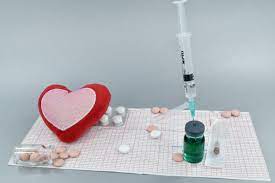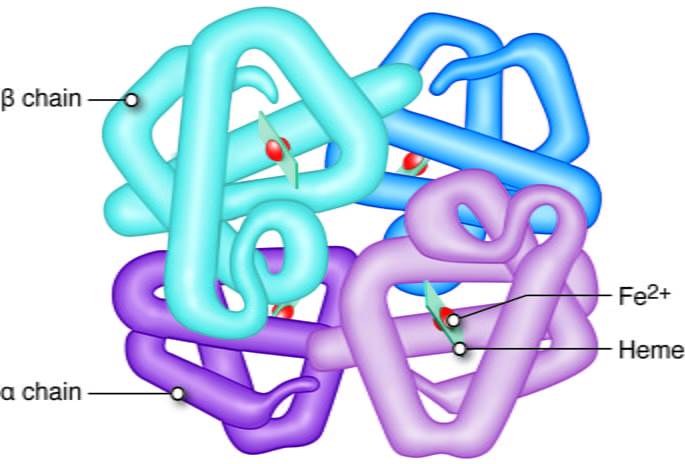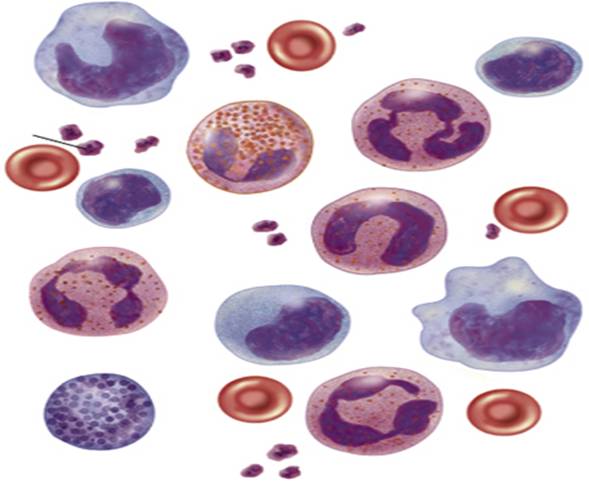Hemoglobin: It is a protein in red blood cells that carries oxygen from the lungs to the tissues of the body and carbon dioxide from the tissues back to the lungs. It is made up of four subunits, each of which contains a heme group. The heme group is a ring-shaped molecule that contains an iron atom. The iron atom is what binds oxygen. In this article, we’ll delve into the normal structure of hemoglobin and explore various variants that can affect its function.
It is a protein molecule found in red blood cells (RBCs) that plays a pivotal role in transporting oxygen from the lungs to various tissues throughout the body. It also aids in the transport of carbon dioxide, a waste product, from the tissues back to the lungs for exhalation. To comprehend hemoglobin’s functions fully, let’s first explore its normal structure.
The Normal Structure of Hemoglobin
It is composed of four protein subunits, each bound to a heme group containing iron. This iron molecule is crucial for oxygen binding. The four protein subunits are categorized into two alpha chains and two beta chains. The specific arrangement of these subunits forms different types of hemoglobin, each with distinct properties and functions.
It is a protein that carries oxygen in the blood. It is composed of four subunits, each containing a heme group and a globin chain. The type of globin chain determines the type of hemoglobins. Normal adult (HbA) has two alpha and two beta chains, while fetal hemoglobin (HbF) has two alpha and two gamma chains. There are also other variants that result from mutations in the globin genes, such as hemoglobin S, C, D, or E. These variants can affect the structure, function, and stability of hemoglobin, and cause various blood disorders .
To understand the normal structure and variants of hemoglobins, it is helpful to know some basic concepts:
- Heme group: A ring-shaped molecule that contains an iron atom in the center. It binds to oxygen and gives hemoglobin its red color.
- Globin chain: A long chain of amino acids that folds into a three-dimensional shape. It holds the heme group and interacts with other globin chains to form a hemoglobin subunit.
- Hemoglobin subunit: A combination of a heme group and a globin chain. There are four subunits in each molecule.
- Hemoglobin molecule: A tetramer of four hemoglobin subunits. It has a quaternary structure that allows it to change shape when it binds or releases oxygen.
Functions of Hemoglobin
The primary function is to bind to oxygen in the lungs and release it in tissues with lower oxygen concentrations. This ability to bind and release oxygen is facilitated by the iron molecule within the heme group. Additionally, it aids in the transportation of carbon dioxide, a waste product, from the body’s tissues to the lungs, where it is exhaled.
Variants
A hemoglobin molecule that has a different globin chain than the normal HbA. It can be inherited or acquired, and can have different effects on the oxygen-carrying capacity and stability.
The following table summarizes some of the common variants and their characteristics:
| Variant | Globin Chain Composition | Cause | Effect |
|---|---|---|---|
| HbF | α2γ2 | Normal in fetuses and newborns, persists in some adults | Higher affinity for oxygen than HbA, protects against malaria and sickle cell disease |
| HbS | α2βS2 | Mutation in the beta globin gene, common in people of African descent | Causes sickle cell disease, a condition where red blood cells become rigid and sickle-shaped, leading to anemia, pain, and organ damage |
| HbC | α2βC2 | Mutation in the beta globin gene, common in people of African descent | Causes hemoglobin C disease, a mild form of hemolytic anemia, where red blood cells are destroyed faster than normal |
| HbD | α2βD2 | Mutation in the beta globin gene, common in people of Asian and Middle Eastern descent | Usually asymptomatic, but can cause mild hemolytic anemia when inherited with another variant |
| HbE | α2βE2 | Mutation in the beta globin gene, common in people of Southeast Asian descent | Usually asymptomatic, but can cause mild hemolytic anemia when inherited with another variant |
There are many other variants that have been discovered, each with their own biochemical properties and clinical correlates. Some of them can interfere with the measurement of hemoglobin A1c, a test that monitors blood glucose levels in people with diabetes. Therefore, it is important to identify and characterize the variants for accurate diagnosis and treatment of blood disorders and diabetes.
Factors Affecting Hemoglobin Levels
levels can be influenced by various factors, including nutritional status, altitude, age, and certain medical conditions. Adequate iron, vitamin B12, and folic acid intake are crucial for maintaining optimal levels.
Conclusion
In conclusion, it is a remarkable molecule that ensures our body’s cells receive the oxygen they need for optimal function. Understanding its normal structure and the various variants that can arise due to genetic mutations is crucial in diagnosing and managing certain health conditions.








